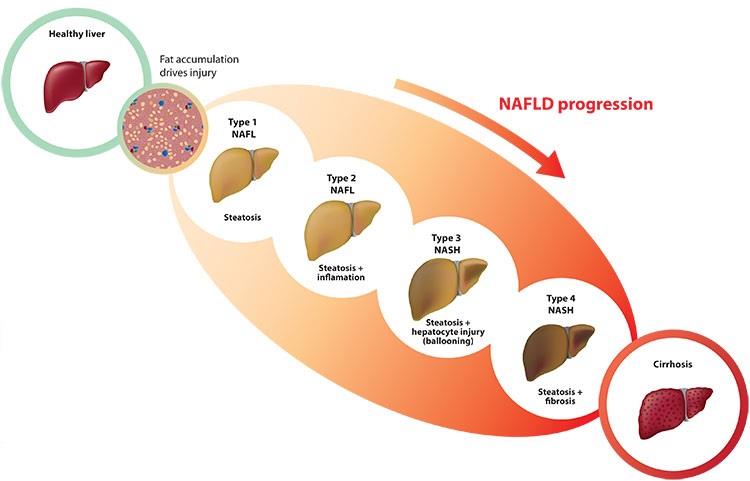Non-alcoholic fatty liver disease (NAFLD) & Non-alcoholic steatohepatitis (NASH)
Non-alcoholic fatty liver disease (NAFLD) is the build up of extra fat in liver cells that is not caused by alcohol.
Nonalcoholic steatohepatitis(NASH), a potentially serious form of the disease, is marked by liver inflammation, which may progress to scarring and irreversible damage. This damage is similar to the damage caused by heavy alcohol use. At its most severe, nonalcoholic steatohepatitis can progress to cirrhosis and liver failure
Nonalcoholic fatty liver disease is increasingly common around the world, especially in Western nations. It occurs in every age group but especially in people in their 40s and 50s.
Causes
Nonalcoholic fatty liver disease and nonalcoholic steatohepatitis are both linked to the following
- Overweight or obesity
- Insulin resistance
- High blood sugar (hyperglycemia) indicating prediabetes & type 2 diabetes
- High levels of fats, particularly cholesterol and triglycerides, in the blood
- Metabolic syndrome
- Polycystic ovarian disease
- Sleep apnea
- Underactive thyroid (hypothyroidism) and underactive pituitary (hypopituitarism)
- Increased total homocysteine level
These combined health problems appear to promote the deposit of fat in the liver. For some people, this excess fat acts as a toxin to liver cells, causing liver inflammation and nonalcoholic steatohepatitis, which may lead to a buildup of scar tissue (fibrosis) in the liver. With continued inflammation, fibrosis spreads to take up more and more liver tissue. About 20 percent of people with nonalcoholic steatohepatitis will progress to cirrhosis.
Diagnosis
- Liver function tests
- Ultrasound abdomen
- Fibroscan
Symptoms
Nonalcoholic fatty liver disease usually causes no signs and symptoms. When it does, they may include:- Enlarged liver
- Fatigue
- Pain in the upper right abdomen
- Abdominal swelling (ascites)
- Enlarged blood vessels just beneath the skin's surface
- Enlarged breasts in men
- Enlarged spleen
- Red palms
- Yellowing of the skin and eyes (jaundice)
- Fluid buildup in the abdomen (ascites)
- Swelling of veins in your esophagus (esophageal varices), which can rupture and bleed
- Confusion, drowsiness and slurred speech (hepatic encephalopathy)
- Liver cancer
- End-stage liver failure, which means the liver has stopped functioning
Prevention
To reduce your risk of nonalcoholic fatty liver disease:
- Control your diabetes.
- Lower your Cholesterol & Triglycerides
- Choose a healthy diet. Choose a healthy plant-based diet that's rich in fruits, vegetables, whole grains and healthy fats.
- Maintain a healthy weight. If you are overweight or obese, reduce the number of calories you eat each day and try to lose weight.
- Exercise: Exercise most days of the week.





